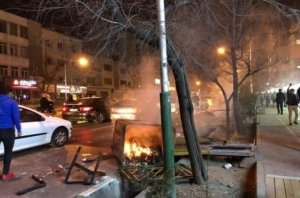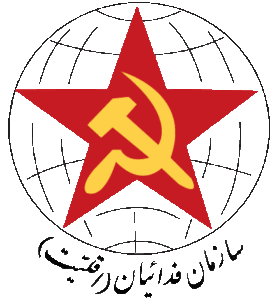Characteristic features of the Current moment regarding the political situation in Iran
 Social and political protests in recent weeks, months, and changes which occurred among the political alignments of Iranian society, caused a new step in emerging a different balance of political and class forces: those against the dominant, and those who guard it.
Social and political protests in recent weeks, months, and changes which occurred among the political alignments of Iranian society, caused a new step in emerging a different balance of political and class forces: those against the dominant, and those who guard it.
The general dissatisfaction with the status quo is not a new phenomenon in Iran. The discontent and protest, for many years have been there and in their various forms risen up. But despite all the struggles of the working class, teachers and scattered mass movements here and there, what made political progress of the revolutionary movement of the masses of workers and toilers be slow and delayed, had to do with the sort of the political balance that the dominated counter-revolution of Iran tried to give it shape through winning the support of the petty bourgeoisie, especially the petty bourgeoisie range of the modern strata.
Due to the aforementioned balance, the struggles of the working class and the working people did not go beyond certain limits over the past few years.
Nevertheless, over the past few months, two important things have been the reasons of the beginning of breaking this balance and changing it to the benefit of the revolutionary class.
First, as the consequence of the growth and promotion of social awareness, solidarity and the working class organizing in the queues of them, the struggle of this class has reached a new stage of quantitative and qualitative growth.
Sequentially in the mid of 2011 decade, being Preceded the struggle of the workers their triumphs marched further beyond a factory, towards series of common struggle of workers from one productive and services sector to other parts that the outstanding patterns of them were, including joint and harmonious struggles of workers in the petrochemical factories, labor coalmines, and overall electricity and telecommunications workers. However, since a few the working class have interred into is a new stage that its political character is clearly highlighted by the struggle of “Hepco” and “Azar” workers. The workers of these factories continued not only for a long time striking on the purpose to settle their demands, but they also turned the streets of Arak into a class battle field as well. Along with radical slogans and speeches, they directly targeted high-level government officials while condemning them for corruption within the state apparatus, lashed out at domestic and foreign policies of the regime while expressing their disgust with the current ruling capitalist order. Such a struggle causes ashift in the balance between classes and political forces. Meanwhile, coupled with the growing radicalization of workers, the retirees’ movement has converted into one of active movements among opposition. During recent months, the last movement has held a series of rallies, rounds, and demonstrations with politically radical slogans against the regime and its officials.
Other active movements have occurred in a number of cities against unemployment and environmental pollution. These Movements had political characteristics and Anti-regime trend within which the slogans against Regime were apparently being chanted.
Another important factor, which played a role to lead the changes in the balance of political power were that the modern layers of the petty bourgeoisie turning away from Islamic Republic.
They [these above groupings] were once part of a force affiliated with the so-called reformist faction, who have now separated from this faction. This separation left an end to the fascination of parts of the modern petty bourgeoisie toward “reforms” during past elections. Their rejection of reformists” means separating from the whole of the state [rulers]. Reformists, regarding their role in maintaining the political balance in the favor of the regime, were virtually and literally bulwark against the revolutionary movement and at the same time considered an obstacle in the way of overthrowing the regime. At the present time, even if the foresaid social layers are not supporters in favor of overthrowing and revolution, the neutrality position of them toward revolutionary movement of the working class.
All what noted above, as a whole all reflects the future changes, which in its turn, in the balance of political power has happened and acted in the favor of the revolution and overthrow the Islamic Republic and against the interests of the Iran’s regime and ruling class.
Iranian society is sooner than ever at a stage that has been subjected to a revolutionary crisis.
It is no surprise that the ruling class is facing bankruptcy and revealing its inadequacies for all to see. Despite all the ostensible promises of Hassan Rouhani’s, the economic crisis of stagnation persists and no prospects would be imagined for the improvement and reduction of incrementional poverty, unemployment and financial pressures and multiple hard livelihood on the yoke of the working masses.
In the current Budget bill, the Cabinet has once attempted to impose the burden of the its bankruptcy on the shoulders of the masses. They have eliminated subsidies for bread, removed cash subsidies for millions of people, and raised prices including gas and other energy sources, the increase in indirect taxation and adding up the variety of duties and taxes.
The consequences of Neo-Liberal economic programs and policies up to date have led to more than ten million unemployed period. The vast majority of the society is below poverty levels, increasing addiction, prostitution, begging, street children, hunger for tens of millions of people. The crime rate has also risen, thereby causing more than 200,000 peoples imprisonments, increased daily executions, and increased overall widespread corruption in all official organs of the State. The Islamic Republic is not able to solve any of the problems of society.
The same is true concerning the political and democratic demands of the Iranian people. It is not essentially in the nature of the government to recognize these demands. So hereupon, the antagonism between the masses of the Iranian people with the autocratic regime is escalating either. The intensification of these contradictions means intensifying the struggle
The Islamic Republic does not own any other tool to deal with this conflict, except for intensifying crackdown. However, when this crisis would break out, all the real evidences in the fields including socio – economic and political phenomena ascertain its occurrence as though, thereafter, even all the armed forces of Iranian regime, would be too inefficient to confront the social combat of the people; especially the most militant, most radical and uncompromising class of history.
(Kaar-No.756; Jan. 26, 2018)


